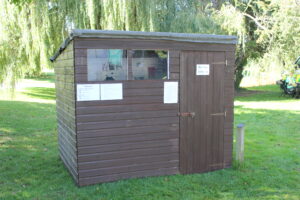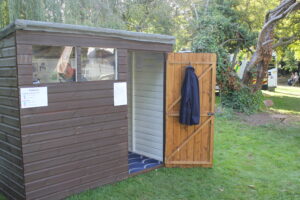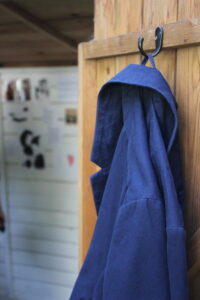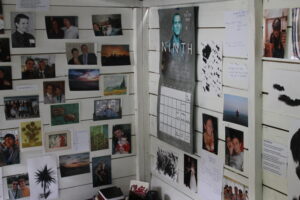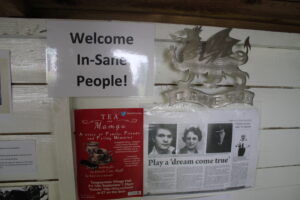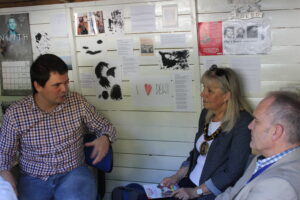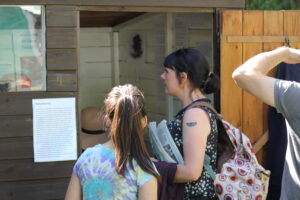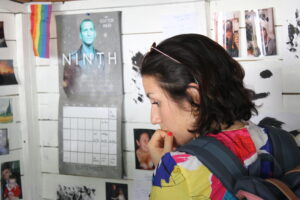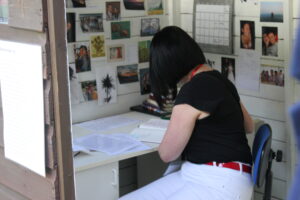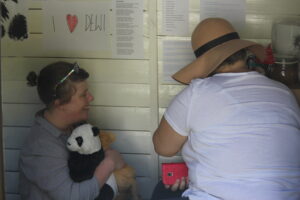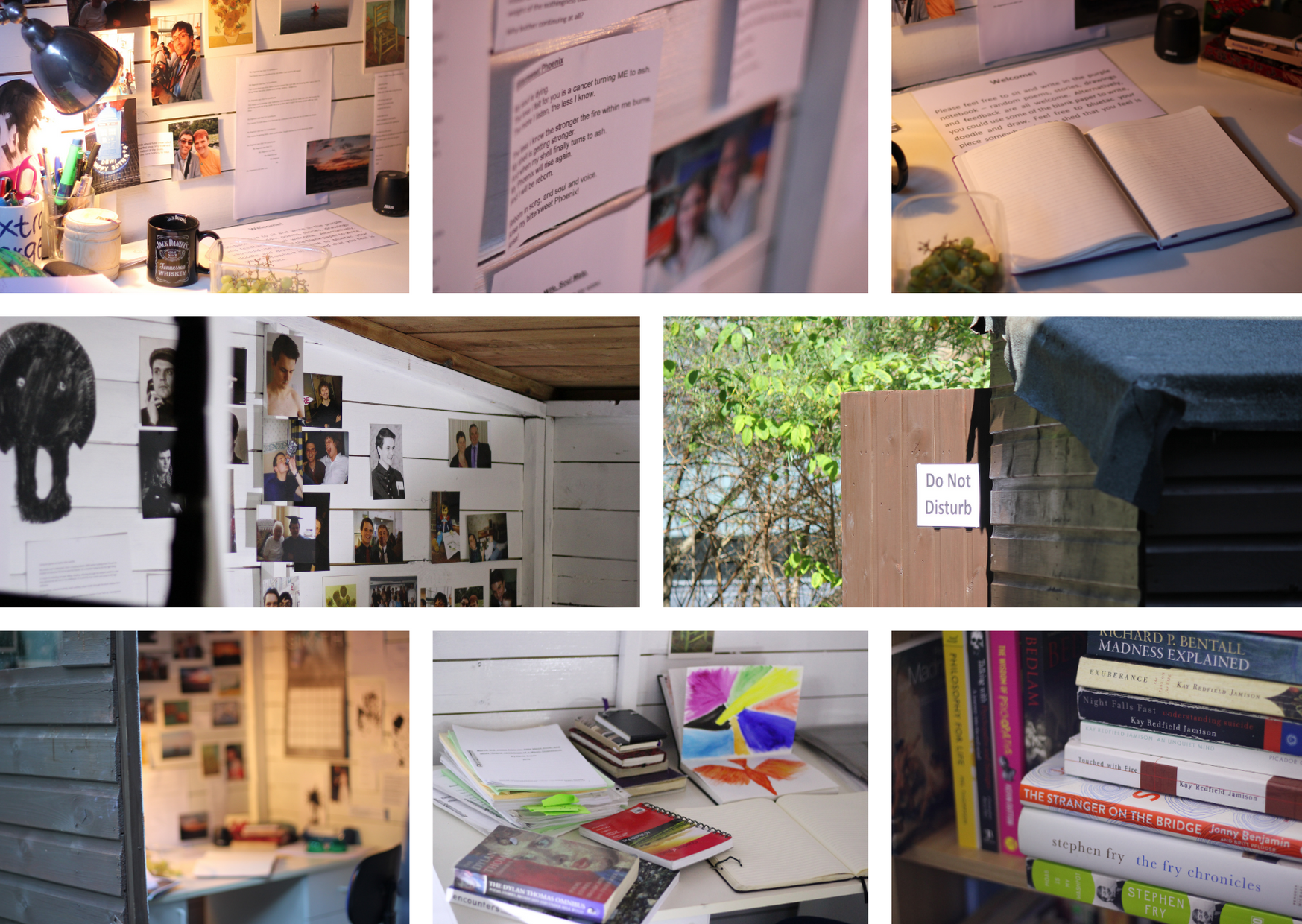
About Shedding My Mental Illness
Shedding My Mental Illness was performed at several festivals throughout 2019, and will make a proud return to Fluid Motion’s All in the Mind Festival in 2021 (COVID permitting!) If you would like Dewi to bring Shedding My Mental Illness to you please drop us an email by clicking here
Shedding My Mental Illness toys with notion of what is real and what is imagined or constructed through the use of a writer shed and fragments of writing were created was in a state of mental distress. Performed inside a 7 x 6’ garden shed which is roughly the same size as the writing shed of Dylan Thomas and the Writing Hut of Roald Dahl the piece is divided into three distinct components “Watching”, “Meeting” and “Remembering” that allow the audience member to view the work and the artist in three distinct ways. Created as a growing and organic piece, which changes, morphs, and adapts with the ebbs and flows of Evans’ life, no two visits to Shedding My Mental Illness are ever the same, and visitors who return after a year or so are often shocked to find how much has changed, and how much has stayed the same.
The first section of the performance entitled “watching” allows the audience member to peer through the windows of the writers shed and view the space as a voyeur passing by whilst I work. This voyeuristic experience allows audiences to peer into a private moment and also symbolises the fact that no matter how hard we look and no matter how much the performer chooses to share, we will never truly understand them. This has a duality with sufferers of mental illnesses, no matter how much they as sufferers chose to share, their mental distress remains individual and difficult to truly understand. By peering through the little windows of my shed the audience members are invited to view myself and the space from the limited viewpoint and create their own ideas about who I am, what I am working on and why the objects inside my shed are important to me and my illness. This element of watching also reflects clinical observations made by mental health staff that the attempt to gain understanding of their patient/client.
“Meeting” offers the audience member the chance to meet Dewi Evans the person in the and join him for a cup of tea or coffee and chat about his work, illness and the contents of the writers shed. This section of the performance allows the audience to question whether they are meeting the person or the performed self of Dewi Evans and to be guided through his work as a writer/performer and through the constructed world of the writer shed. By being physically present in the space Dewi also acts as a physical barrier to fully exploring the space, as audience members are unlikely to rummage through desk drawers and open books whilst the person/performer is present. The performance allows the audience member to not only ask questions about the various bits of writing and artefacts present in the space but also allows them to ask questions of Dewi with regards to his bipolarity and mental distress. This gentle meeting between Dewi and one or two participants is reminiscent of a counselling session or discussion about illness with friends. The aim of this section is to show Dewi Evans as a stable person who may even ‘pass’ as sane. This contrasts the writing in the shed which shows the insane or mad side of Dewi and his mental illness.
The ‘Remembering’ section of the performance removes the performer from the space allows the audience member to explore the writer shed and its content on their own. This section of the performance allows the audience member to rummage through drawers, pick up objects and engage with the space but not the performer/person. This exploration of the space allows the audience to develop their understanding of Dewi Evans and his relationship to the artefacts that have been left behind in the space. And mirrors the investigation that Dewi Evans’ love ones, mental health services or the police may undertake of the space should he disappear, be sectioned or commit suicide. By removing himself from the space Dewi Evans is inviting you to examine closely his written works and the areas of the shed that inaccessible when he is present such as the drawers, bookcases, books. This section of the performance is designed to mimic tourist attractions and engagement between site and visitor that is present at places such as Dylan Thomas’s Writing Shed on The Boat House in Laugharne, West Wales and Roald Dahl’s writers’ hut at the Roald Dahl Museum and Story Centre in Great Missenden and brings a performance full circle as once again the audience act voyeuristically in gaining understanding of the performer to the shards of information that are left that offer them only 1⁄2 picture.
The ‘mental’ writings that are stored and displayed within the writer shed blurs the lines between whether the shed is a site of creative exploration, a safe space, and mental health confinement. Inspired by the writer sheds of Dylan Thomas and Roald Dahl “Shedding my mental illness” offers participants the chance to enter the writing shed of Dewi Evans and meet the man himself. Whilst in the shed participants are offered a cup of tea or coffee and some light refreshment and offer the chance to discuss Evans’s works and their inspiration: Evans’s own mental illness. Part performance, part question and answer, part site-specific installation Shedding My Mental Illness is quite literally ‘hut-stuff’.
Audience Feedback
‘Shedding My Mental Illness’ invites the audience to peer through the window into the work, life and mind of its creator Dewi Evans. As we look through the glass, so we can begin to wonder what it’s like to be a person with mental ill health who is subjected to ‘observation’ without consent. As mere onlookers, can we really know what a person is thinking or feeling simply by watching what they do? And who is it that defines behaviours as ‘normal’ or not? Would any of us pass a test of acceptability if our behaviours were watched and scrutinised under a constant clinical glare, especially when permission for such intrusion hasn’t been given? Continuing in the tradition of Virginia Woolf, Dylan Thomas and Roald Dahl, Dewi’s writing shed brings forth words, ideas and reflections that are transformative in how we view mental ill health and what we think of those who receive a diagnosis of being different.
Joanna Foster BA(Hons) Oxon PGC, Managing Director, Fabtic (working with at-risk children, specialising in juvenile fire setting behaviour)
‘The more I sit here, the more obsessed I am. We all need sheds like this!’
Jess, Audience Member.
‘Inspiring! This is the way we can leave it all! Out there, not in here.’
Anonymous Audience Member
‘Very open, honest and incredibly brave to allow yourself to be viewed in this way. I am studying to be a councillor and today has helped me no end, so again, thank you! Good luck with your shed! Its fabulous!’
Nikki, Audience Member.
‘I would have liked to have stayed and chatted, but I had to head straight home and blub like a baby for a couple of hours. [The] work genuinely touched me’
Anonymous Audience Member
